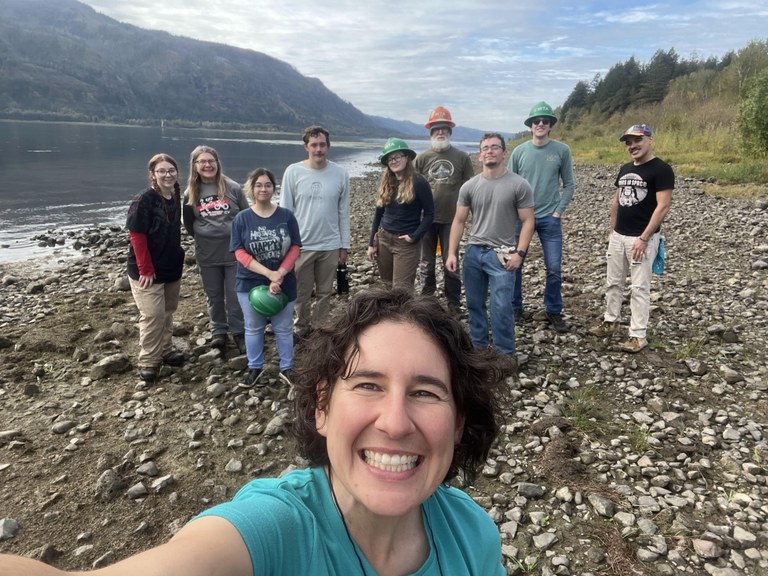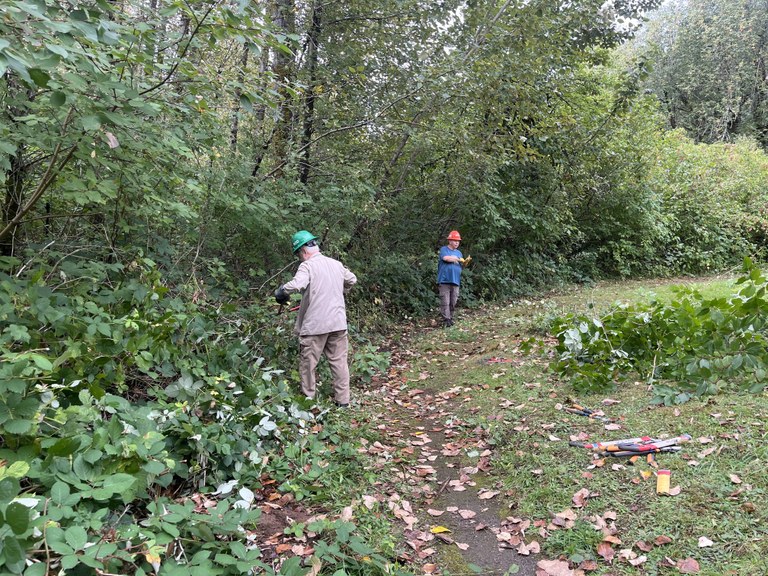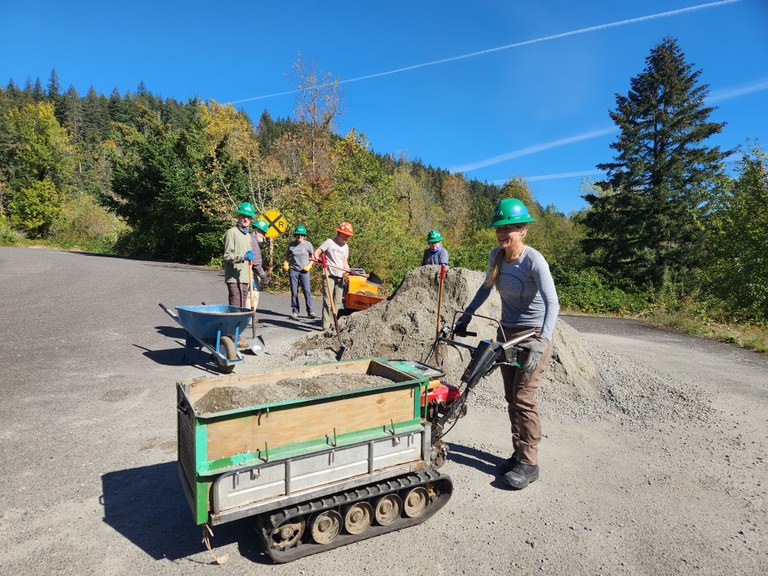Volunteers restore accessible trail in the Columbia River Gorge
How many elephants worth of gravel does it take to refinish a trail?
By Chloe Ferrone
For many hikers, success is measured in the number of miles hiked. In the trail building world, we often measure progress in the feet of trail — or tread — built. But for volunteers in Southwest Washington, a recent project involved moving so much gravel that the easiest way to wrap our heads around it was to measure it in elephants.
Over the course of 11 work parties, volunteers restored an ADA accessible trail in the Columbia River Gorge National Scenic Area, moving and compacting over 90 tons of gravel weighing the equivalent of 13-15 full-sized elephants.

Volunteers moved and compacted over 90 tons of gravel to restore the St. Cloud Accessible Loop Trail in the Columbia River Gorge National Scenic Area. Photo courtesy Kathy Garmus.
A scenic stop along the Columbia River
The St. Cloud day use area lies along the Washington side of the Columbia River Gorge National Scenic Area, approximately 40 minutes east of Vancouver.
“The whole gorge is amazing, full of waterfalls and little tributaries running into the Columbia River. From St. Cloud you can see waterfalls across the river in Oregon, plus all the trees and surrounding mountains. It’s a really special place,” said Stasia Honnold, WTA’s Southwest regional coordinator.
The area has been on WTA’s radar since 2014, when WTA learned that the ADA accessible trail was no longer wheelchair friendly. Due to budget cuts, the Forest Service has had a difficult time maintaining the area, and in fall of 2024 WTA stepped up to help restore the St. Cloud Accessible Trail.
The half-mile loop trail offers a peaceful stroll through a historic apple orchard, with views of the surrounding bluffs, mountains and the mighty Columbia River. Wetland areas are home to winter ducks and other birds. One recent observation from a trip reporter described the cedar waxwings that were active in the morning, along with other birds. The area is also partly forested, with Douglas firs and western hemlocks providing shade for hikers and wildlife.
New faces and leadership in the Southwest region
The series of 11 work parties began in September and continued through the end of December. Many of the work parties were either half days or special events in conjunction with partners. Stasia said that, throughout the months working on the project, a wide variety of volunteers showed up, but a common theme was new opportunities — both for the volunteers and the leadership. WTA work parties usually run from 8:30 a.m. to around 3:00 p.m., but Stasia explained that shorter work days ended up working in their favor.
“Because a lot of our work days were half days, I think it enticed first time volunteers to come out, or people who maybe hadn’t been out for a while came back to it because it was a shorter day. Plus, it’s easier to approach the monotony of hauling gravel if you only have to do it for half a day,” Stasia said. “It also helped that we had consistently good weather for most of the days we were out there.”
One new group of volunteers that worked on the St. Cloud trail were students from WSU Vancouver’s Outdoor Recreation Program. WTA has partnered with WSU over the past 2 years for various on-campus projects, but St. Cloud was their first opportunity to work offsite.

WSU students and teachers pause their work for a selfie on the shoreline with Stasia Honnold, WTA’s Southwest regional coordinator. Photo courtesy of Stasia Honnold.
The St. Cloud trail was also a great project for new crew leaders in the Southwest region — the result of a pilot program that Stasia created to encourage assistant crew leads to make the jump to becoming a crew leader.
“I sent out a request to the assistant crew leaders we thought were ready for the next steps or who’d expressed interest in being a crew leader,” Stasia said. “Then we did three work parties together with each of the new leaders, and over the course of the 3 days I would slowly hand off more responsibility to them, until they were leading and I was mostly in the background to offer support if they needed it.”
By the time the funding, scheduling and equipment came together for the St. Cloud trail, Stasia had recruited and onboarded three new crew leaders, each of whom ended up leading work parties at St. Cloud. Crew leader Emma Royce kicked off the project.
“It was exciting to lead the work party to break ground on the St. Cloud project, especially as I have visited the park many times in my childhood,” Emma said. “My favorite part of the project has been watching this park just off Highway 14 go from a forgotten, neglected public space, to a well cared for trail. Growing up in Southwest Washington, I have always loved all the access to the Columbia Gorge from my home, and fixing up beloved Gorge access spots is a cause close to my heart.”
Restoring the St. Cloud Trail
The St. Cloud project was completed in three stages. First, volunteers worked to cut back the brush that had crept in and narrowed the trail down to just a thin dirt track. Once the surrounding brush was removed and the corridor was reestablished, crews went in with grubbing tools to widen the tread and restore it to ADA accessible standards.

Volunteers work to clear branches and brambles and re-establish the trail corridor prior to working on the tread. Photo courtesy of Stasia Honnold.
“This was surprisingly the hardest part,” Stasia said. “You’d think it’d be the gravel, but removing that grass layer and widening the tread back to 40 inches wide the entire length of the trail was the toughest part.”
As fall progressed, volunteers uncovered the gravel bed of the original trail, taking breaks to sample the variety of apples ripening in the orchard.
From there, volunteers hauled over 90 tons of gravel, using both mechanized and non-mechanized wheelbarrows. They first put down a layer of coarse gravel and compacted it. Then volunteers came back through and layered finer gravel on top, compacting that, too. Hauling gravel can be a daunting task, but the volunteer crews weren’t fazed. Instead, they watched with satisfaction as the enormous pile of gravel in the parking lot dwindled to nothing.
“It’s always amazing to watch that giant pile disappear,” Stasia said.
The final product was a newly widened, compacted, accessible trail that meanders through the historic apple orchard and takes hikers on a gentle loop trail with views of the Columbia River and surrounding mountains. An informal spur trail branches off from the graveled trail at one point, providing direct access to the river.

A volunteer uses a mechanized compactor to smooth and compact the trail. Photo courtesy of Kathy Garmus.
Partnerships and grants help complete the project
At times, the St. Cloud project was an exercise in dealing with unknowns. Towards the end of 2024, a looming possible government shutdown cast doubt on whether crews would be allowed to work on federal land, pushing volunteers to finish the work before the potential disruption. But through all the uncertainty, the positive relationship between WTA and the USFS shone through. WTA crews were able to borrow gravel toters (mechanized wheel barrows) and a plate compactor from the Forest Service.
“We owe a huge thank you to the folks at the Forest Service,” Stasia said. “They were really amazing about lending equipment and taking that expense out of the equation, and their coordination efforts made it easy to stick to our timeline.”

Mechanized toters and compactors loaned from the Forest Service helped the process along. Photo courtesy of Jim C.
In addition to the partnership with the Forest Service, a National Forest Foundation grant also played a key role in making this project possible. Thanks to their support we were able to purchase all the gravel as well as staff many of the work parties.
Today, you can visit the St. Cloud day use area and walk the newly refinished trail. You can wander down to the river’s edge, explore the historic orchard and enjoy a quiet picnic with views of the river. This trail is hikeable in the winter, and is a great stopping point on your way further up the Gorge to visit other trails, such as Beacon Rock and Dog Mountain. And, if you're interested in helping with projects similar to this one, check out our list of volunteer work parties for opportunities near you.


Comments